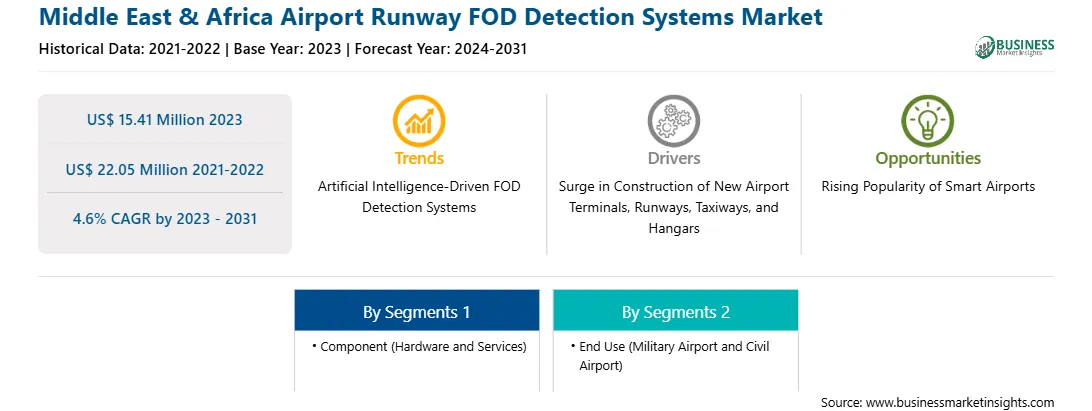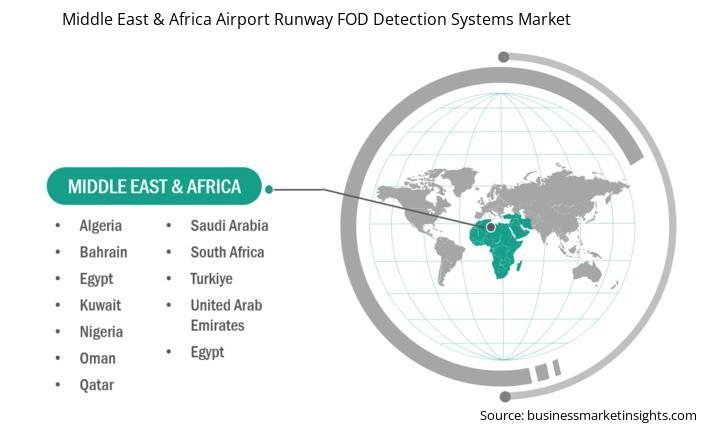The Middle East & Africa airport runway FOD detection systems market was valued at US$ 15.41 million in 2023 and is expected to reach US$ 22.05 million by 2031; it is estimated to register a CAGR of 4.6% from 2023 to 2031.
The adoption of advanced technologies such as the Internet of Things (IoT), cloud, blockchain, and artificial intelligence (AI) by the aerospace & defense industry is projected to increase in the coming years. The implementation of high-end technologies supports organizations to modernize the manufacturing of components, streamline operational processes, ensure improved safety of the aircraft and passengers, and process large volumes of data. For instance, ArgosAI offers A-FOD that confers features such as enhanced real-time detection of FOD, analysis tools for managing runways, and alarm generation systems; it is an artificial intelligence-based automated airport runway FOD detection system. Thus, the rising adoption of artificial intelligence-driven FOD detection systems is expected to bring new trends to the airport runway FOD detection systems market in the coming years.
The aviation industry plays an important role in facilitating global connectivity and economic development. The demand for efficient and modern airport facilities has been on the rise across the globe. According to the Airport Council International (ACI), the Middle East is expected to account for more than one billion of the global air passenger demand by 2040. As a result, airport infrastructure development in the Middle East requires an investment of US$ 151 billion to expand capacity. With over 110 airports, the Middle East is already one of the fastest-growing airports worldwide, accounting for 170 million of global traffic. According to the ACI forecast, more than US$ 150 billion in investment is required to build airport infrastructure from 2021 to 2040 to fulfill the need to manage growing air passenger traffic.
The Middle East & Africa is experiencing substantial airport infrastructure expansion and developments, fueled by economic growth and an increasing focus on becoming global aviation hubs. Major airports such as Dubai International, Hamad International, and King Fahd International are leading the region's modernization efforts by incorporating cutting-edge technologies and extensive expansion projects. For example, Jeddah Airport Company is aimed at expanding King Abdulaziz International Airport with an investment of US$ 31 billion by 2031. Through this project, the airport is expected to manage 114 million passengers per year.
Governments of various countries in Africa are working on various initiatives to meet the growing demand for air travel. Among African countries, the aviation sector in South Africa is the most technologically advanced and has the highest number of passengers, cargo volume, aircraft fleet, and airports. The country's government is also focused on matching the capabilities of other developing countries, which strengthens the country's aviation sector, especially in terms of aircraft fleet and airport infrastructure. The South African government's focus on airport infrastructure, in collaboration with the Airports Company South Africa (ACSA), demonstrates the growth of airport infrastructure in the country through the expansion of existing airports. The expansion projects involve boosting the number of runways and terminals at various airports in the country. Thus, an increase in the number of runways is expected to fuel the growth of the airport runway FOD detection systems market in the Middle East & Africa from 2023 to 2031.
Strategic insights for the Middle East & Africa Airport Runway FOD Detection Systems provides data-driven analysis of the industry landscape, including current trends, key players, and regional nuances. These insights offer actionable recommendations, enabling readers to differentiate themselves from competitors by identifying untapped segments or developing unique value propositions. Leveraging data analytics, these insights help industry players anticipate the market shifts, whether investors, manufacturers, or other stakeholders. A future-oriented perspective is essential, helping stakeholders anticipate market shifts and position themselves for long-term success in this dynamic region. Ultimately, effective strategic insights empower readers to make informed decisions that drive profitability and achieve their business objectives within the market.

| Report Attribute | Details |
|---|---|
| Market size in 2023 | US$ 15.41 Million |
| Market Size by 2031 | US$ 22.05 Million |
| CAGR (2023 - 2031) | 4.6% |
| Historical Data | 2021-2022 |
| Forecast period | 2024-2031 |
| Segments Covered |
By Component
|
| Regions and Countries Covered | Middle East and Africa
|
| Market leaders and key company profiles |
|
The geographic scope of the Middle East & Africa Airport Runway FOD Detection Systems refers to the specific areas in which a business operates and competes. Understanding local distinctions, such as diverse consumer preferences (e.g., demand for specific plug types or battery backup durations), varying economic conditions, and regulatory environments, is crucial for tailoring strategies to specific markets. Businesses can expand their reach by identifying underserved areas or adapting their offerings to meet local demands. A clear market focus allows for more effective resource allocation, targeted marketing campaigns, and better positioning against local competitors, ultimately driving growth in those targeted areas.

The Middle East & Africa airport runway FOD detection systems market is categorized into component, end use, and country.
Based on component, the Middle East & Africa airport runway FOD detection systems market is bifurcated into hardware and services. The hardware segment held a larger Middle East & Africa airport runway FOD detection systems market share in 2023.
In terms of end use, the Middle East & Africa airport runway FOD detection systems market is categorized into military airport and civil airport. The civil airport segment held a larger Middle East & Africa airport runway FOD detection systems market share in 2023.
By country, the Middle East & Africa airport runway FOD detection systems market is segmented into South Africa, the UAE, Saudi Arabia, and the Rest of Middle East & Africa. The UAE dominated the Middle East & Africa airport runway FOD detection systems market share in 2023.
ArgosAI Teknoloji A.Ş; Moog Inc, Rheinmetall AG, QinetiQ Group Plc, Thales SA, Xsight Systems Ltd.; Smiths Detection Group Ltd.(Smiths Group plc); Infologic Pte Ltd.; and Hitachi Ltd are some of the leading companies operating in Middle East & Africa airport runway FOD detection systems market.
The Middle East & Africa Airport Runway FOD Detection Systems Market is valued at US$ 15.41 Million in 2023, it is projected to reach US$ 22.05 Million by 2031.
As per our report Middle East & Africa Airport Runway FOD Detection Systems Market, the market size is valued at US$ 15.41 Million in 2023, projecting it to reach US$ 22.05 Million by 2031. This translates to a CAGR of approximately 4.6% during the forecast period.
The Middle East & Africa Airport Runway FOD Detection Systems Market report typically cover these key segments-
The historic period, base year, and forecast period can vary slightly depending on the specific market research report. However, for the Middle East & Africa Airport Runway FOD Detection Systems Market report:
The Middle East & Africa Airport Runway FOD Detection Systems Market is populated by several key players, each contributing to its growth and innovation. Some of the major players include:
The Middle East & Africa Airport Runway FOD Detection Systems Market report is valuable for diverse stakeholders, including:
Essentially, anyone involved in or considering involvement in the Middle East & Africa Airport Runway FOD Detection Systems Market value chain can benefit from the information contained in a comprehensive market report.